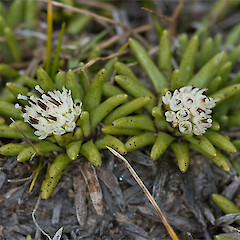Abrotanella inconspicua
Family
Asteraceae
Flora category
Vascular – Native
Endemic taxon
Yes
Endemic genus
No
Endemic family
No
Structural class
Herbs - Dicotyledonous composites
NVS code
The National Vegetation Survey (NVS) Databank is a physical archive and electronic databank containing records of over 94,000 vegetation survey plots - including data from over 19,000 permanent plots. NVS maintains a standard set of species code abbreviations that correspond to standard scientific plant names from the Ngä Tipu o Aotearoa - New Zealand Plants database.
ABRINC
Chromosome number
2n = 18
Current conservation status
The conservation status of all known New Zealand vascular plant taxa at the rank of species and below were reassessed in 2017 using the New Zealand Threat Classification System (NZTCS) – more information about this can be found on the NZTCS website. This report includes a statistical summary and brief notes on changes since 2012 and replaces all previous NZTCS lists for vascular plants.
Please note, threat classifications are often suggested by authors when publications fall between NZTCS assessment periods – an interim threat classification status has not been assessed by the NZTCS panel.
- Conservation status of New Zealand indigenous vascular plants, 2017 . 2018. Peter J. de Lange, Jeremy R. Rolfe, John W. Barkla, Shannel P. Courtney, Paul D. Champion, Leon R. Perrie, Sarah M. Beadel, Kerry A. Ford, Ilse Breitwieser, Ines Schönberger, Rowan Hindmarsh-Walls, Peter B. Heenan and Kate Ladley. Department of Conservation. Source: NZTCS and licensed by DOC for reuse under the Creative Commons Attribution 4.0 International licence.
2017 | Not Threatened
Previous conservation statuses
2012 | Not Threatened
2009 | Not Threatened
2004 | Not Threatened
Distribution
South Island, widespread on the higher mountains of Central Otago and the lakes district but extending west locally, almost to the Southern Alps.
Habitat
Low to High-Alpine 1200-2000 metres, in boggy ground in cushionfield vegetation, but not the most exposed sites and late snowbanks. Further west, it occurs locally in exposed snow tussock-herbfield and fellfield.
Detailed description
Forming moss-like patches 10 cm or more across, bright-green. Stock rather stout, multiple heads, emitting on short stolons densely clad in imbricate leaves, branches up to 3 cm. long; Leaves close-set along branches, 6-10 × 1 mm, coriaceous, erect to patent, awl-shaped, curved at tip, narrowly linear to linear-oblong to subulate-oblong, subacute, ciliolate near sheathing base; midrib prominent. Capitula solitary, approximately 3 mm. diameter, subsessile, invested by leaves, barely extend beyond them as the fruits ripen; phyllaries up to 3 mm long, linear-oblong, obtuse, scarious, nerves usually prominent. Florets 15-20; female with slender corolla-tube, 4-lobed; disk-florets sub-funnelform, usually 5-lobed. Achenes approximately 1-2 mm long, linear-clavate, distinctly to obscurely 4-ribbed, pubescent to glabrous.
Similar taxa
Similar to A. patearoa which has broader (1.5-2 mm) blunt leaves and flower stalks that elongate beyond the leaves as the fruits ripen.
Flowering
October-February
Flower colours
Cream, Yellow
Fruiting
November-March
Life cycle
Cypsela are primarily dispersed by wind (Thorsen et al., 2009)
Etymology
abrotanella: Little Artemisia (known as Abrotanus by ancient herbalists)
inconspicua: Inconspicous
Where To Buy
Not commercially available.
Attribution
Description adapted by M. Ward from Mark (2012) & Allan (1961).
References and further reading
Allan, H. H. 1961. Flora of New Zealand. Vol. 1. Wellington: Government Printer. pg. 695.
Mark, A. F. 2012. Above the Treeline: A Nature Guide to Alpine New Zealand. Craig Potton Publishing, Nelson. pg. 198.
Thorsen, M. J.; Dickinson, K. J. M.; Seddon, P. J. 2009. Seed dispersal systems in the New Zealand flora. Perspectives in Plant Ecology, Evolution and Systematics 2009 Vol. 11 No. 4 pp. 285-309.




